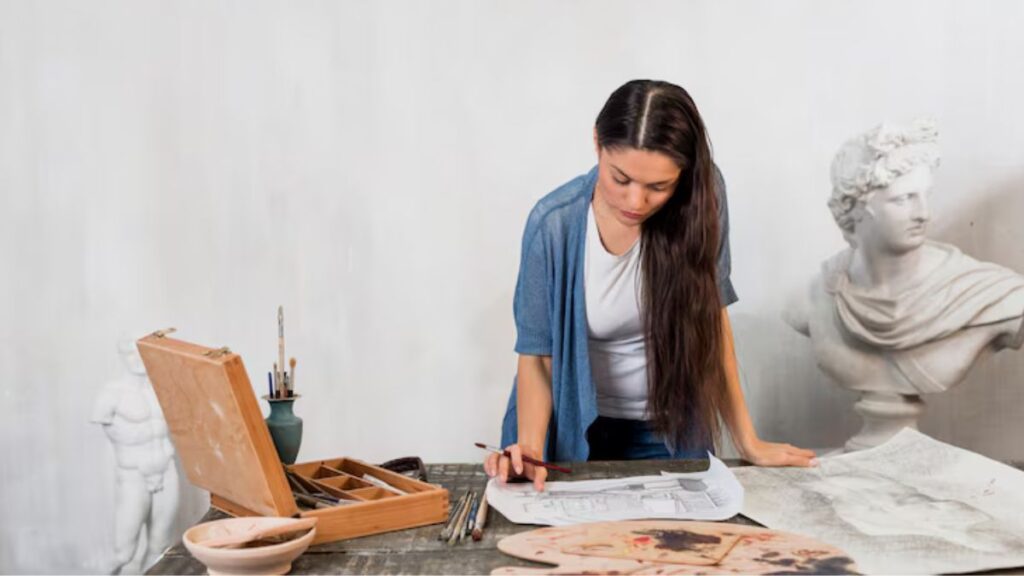In a world obsessed with the future, there’s a certain poetic rebellion in looking back. While the tech tycoons tinker with AI and quantum dreams, there’s a quieter, richer goldmine nestled in our past. Ancient Artz techniques—once dismissed as archaic curiosities—are whispering back into the zeitgeist with surprising relevance. From the alchemical studios of Egyptian priests to the meditative ink strokes of Far Eastern calligraphers, the artz of old are staging a spectacular encore.
What follows is not a listicle of dusty relics or romanticized traditions. This is a deep dive into the clandestine, the mystical, and the masterful—a revelation of time-tested craftsmanship whose secrets have survived empires, crusades, and cultural apocalypses. Welcome to the hidden dojo of human ingenuity. Buckle in.
1. Kintsugi — The Golden Philosophy of Imperfection
Let’s start in 15th-century Japan, where a shogun’s broken tea bowl was returned from China hastily repaired with ugly metal staples. Displeased, he called upon his local artisans to do better. What they gave him was a masterpiece: the shattered ceramic mended with lacquer mixed with powdered gold, transforming the fracture into feature. Thus, Kintsugi was born.
Far beyond aesthetics, Kintsugi is philosophy masquerading as art. It embodies wabi-sabi — the beauty in the broken, the poetic in the imperfect. In today’s image-obsessed, flaw-averse culture, Kintsugi offers radical acceptance and mindful healing. Ceramicists and mental health advocates alike are rediscovering it, not as nostalgia, but as a roadmap to resilience.
Modern adopters? Fashion brands weaving gold thread into distressed denim. Therapists using Kintsugi metaphors in trauma recovery. Digital artists replicating fracture lines on NFTs. Ancient Artz? Yes. Relevant? Hell yes.
2. Ayurvedic Marma Chikitsa — Pressure Points Beyond Acupuncture
Long before needles made their way west from China, the Indian subcontinent was already mapping the subtle anatomy of energy. Marma Chikitsa, a sister technique within Ayurveda, targets 107 “marmas” or vital points where life force (prana) converges.
Unlike acupuncture’s clinical pricks, Marma is a blend of massage, essential oils, chants, and subtle manipulation. Its intent isn’t just to fix pain but to unlock vibrancy. Think of it as performance tuning for the human engine.
Today, elite athletes and wellness junkies are circling back. Cristiano Ronaldo has been spotted consulting Ayurveda experts. Biohackers in Silicon Valley are integrating Marma stimulation into their morning routines. Once cloaked in Sanskrit and sandalwood, Marma is now decoded in scientific journals and wellness retreats alike.
3. Masonic Stone Craft — The Sacred Geometry of Building
There’s architecture, and then there’s symbolic architecture. Masonic stone craft was never just about stacking rocks. It was sacred engineering, geometry as gospel. From the cathedrals of Europe to the pyramids of Egypt, the secret handshakes of proportion and metaphysical mathematics built wonders that have defied decay.
The tools? Compass and square. The method? Allegory. Each brick laid was an act of spiritual metaphor. Today’s resurgence of interest in biophilic design, golden ratios, and energetic space mapping owes more to Freemasonry than to Pinterest.
Modern crossover? Sustainable architecture firms now study old Masonic blueprints for inspiration. Digital designers embed sacred geometries in app interfaces to evoke harmony. Even Elon Musk reportedly studied ancient artz building principles when conceptualizing SpaceX interiors.
Stone doesn’t lie. And neither does legacy.
4. Chinese Ink Wash Painting — Meditation in Motion
Welcome to the Taoist temple of art. With just black ink and rice paper, Chinese literati conjured mountains, rivers, and entire universes. But this wasn’t just visual expression—it was a form of moving meditation, a test of spirit and discipline.
In an era of AI-generated visuals and content overload, Ink Wash offers a sacred pause. It’s the slow food of the art world, demanding presence, breath control, and surrender. No erasing, no undo. Just flow.
Today, the minimalist movement bows subtly to this discipline. UX/UI designers now mimic its whitespace elegance. Mindfulness coaches use brushwork in workshops. Even fashion houses (see: Dior, Hermès) are co-opting ink motifs into their haute couture lines.
This isn’t a comeback. It never left.
5. Byzantine Encaustic Painting — The Hot Wax Renaissance
Before oil painting, before Photoshop, there was beeswax and fire. Encaustic painting, an ancient artz Greco-Byzantine technique, involved mixing pigments into hot wax and applying it to wood or canvas with a heated spatula. The result? Ethereal portraits that glowed like stained glass, impervious to time.
Its rediscovery began with avant-garde painters in the early 20th century. Today, encaustic is the darling of experimental ateliers. Museums are showcasing it not just as preservation, but as provocation.
It’s tactile. It’s temperamental. It’s timeless.
6. Aboriginal Dot Painting — The Codified Canvas of Storytelling
Far beyond mere aesthetics, the dot paintings of Australian Aboriginal communities are spiritual cartographies. Each pattern encodes ancestral stories, songlines, and geography—an ancient artz GPS system rendered in ochre.
Until the 1970s, many symbols were guarded, used only in ceremonial contexts. When Indigenous artists began using acrylics to depict Dreamtime narratives, it wasn’t dilution. It was coded resistance. Hidden in plain sight.
Today, dot painting influences game design, data visualization, and virtual reality patterning. Google commissioned Aboriginal artists for AI interface design. In an age obsessed with storytelling, few art forms tell it deeper.
7. Egyptian Alchemy — The Proto-Chemistry of Transformation
Alchemy wasn’t about turning lead into gold. It was a spiritual metaphor: the purification of the soul through material practice. Ancient artz Egyptian priests, custodians of this craft, coded their knowledge in symbols, gods, and mysterious recipes.
Fast forward to 2025, and guess what? Alchemy is hot again—not just in steampunk novels but in biotech labs. The idea of transformation at the atomic, psychological, and spiritual level is being reframed through quantum theory, neuroplasticity, and nanoscience.
In the wellness world, alchemy manifests in artisanal distillation, scent rituals, and even skincare blends. Lab-grown perfumes are borrowing from ancient artz distillery notes.
Alchemy isn’t pseudoscience. It’s proto-science. And it’s finding its second wind.
8. African Adire — The Indigo Codes of West Africa
Long before tie-dye took over Coachella, the Yoruba women of Nigeria were creating adire: indigo-dyed fabrics layered with hand-drawn resist patterns using cassava paste, feathers, and carved woodblocks.
Each pattern was a code—a lexicon of identity, family, protest, and poetry.
Now, a new generation of African designers are reinterpreting adire for the global stage. It graces Paris runways and Brooklyn boutiques. Sustainable fashion advocates hail it for its eco-dye practices. Even AI pattern recognition researchers study it for its algorithmic complexity.
Adire isn’t just a fabric. It’s a wearable archive.
9. Mayan Mathematics — The Divine Calculation
The Mayans weren’t just pyramid architects; they were numerical mystics. Their vigesimal (base-20) system predated binary logic, and their zero—yes, zero—appeared independently from Babylonian concepts.
They used math not just to measure but to meditate. Numbers guided their calendars, crop cycles, and cosmic ceremonies.
Today, cryptographers and quantum theorists are taking a second look at Mayan math. Its emphasis on cyclicality over linearity could offer blueprints for better blockchain systems and even future AI decision-making models.
Who knew zero had such gravity?
10. Greek Memory Palaces — The Architecture of Recall
Before Google, before notebooks, the Greeks used buildings to remember. Not literal ones, but mnemonic architectures built inside the mind. Picture this: a familiar villa, each room encoding a speech, a story, a system.
This technique, known as the Method of Loci, was the backbone of orators, poets, and philosophers.
Today, memory athletes dominate with the same method. Techies use it to learn code. Students are building VR memory palaces to study for exams. It’s neuroaesthetics meets ancient artz strategy.
You don’t need more data. You need better recall. And the Greeks still hold the keys.
Conclusion: The Future Is Ancient Artz
The more we advance, the more we seem to circle back. Ancient artz aren’t dusty museum pieces—they’re user manuals for the human condition, coded in craft, preserved in practice. In a time where speed is king and originality is algorithmically farmed, these techniques offer what machines can’t: soul.
So whether you’re coding the next big app, designing a home, or just trying to stay sane, maybe peek backward before you press forward.
Because the past isn’t past. It’s patiently waiting.






